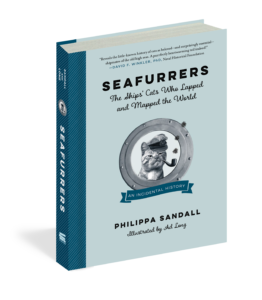The world of popular culture is obsessed with cats; from Grumpy Cat to Pusheen, these attitude-filled fuzzballs have taken over the internet and social media—not to mention the sunny side of the couch. But you might be surprised to learn that this feline obsession extends far back in time, even before the internet was invented! In fact, kitties have been media fodder as far back as 1553, and it was this proliferation of cat history that enabled author Philippa Sandall to write her new book: Seafurrers: The Ships’ Cats Who Lapped and Mapped the World: An Incidental History, illustrated by Adam Long.
Dogs may be “man’s best friend,” but it seems that cats are “sailor’s best friend.” Cats have accompanied sailors out to sea for thousands of years, and not only that, but they were indispensable—both as pest controllers and also as beloved mascots. Sandall cleverly dubbed these feline shipmates “seafurrers,” and in her book, she shares thirty-eight tales of celebrity cats sailing the high seas. Filled with nautical trivia, rare photographs, and whimsical illustrations by Adam Long, this deft genealogy of human–feline friendship will stir your regard for the incomparable cat—whether on the couch or in the crow’s nest!
In anticipation of the book’s release on April 3, we chatted with Philippa Sandall and Adam Long about the book, their process, and (obviously) their favorite cats. Read on for the Q&A and preorder the book here! 
Q: First, and most importantly, are you both cat lovers?
Philippa Sandall: I’m not sure I qualify as a serious “cat lover” by today’s standards, but I come from a family that’s always had a cat and sometimes a cat that had kittens which was pretty exciting. Some cats were given by friends; others just arrived on our doorstep, made themselves at home and stayed for years.
Adam Long: As a three-year-old, I chose the name Teddy Tip-toes for our first family cat, and was deeply upset when we moved to another city and left him behind. Tiger soon took Teddy’s place, and other cats followed—until, as a teenager, I became deeply allergic. I have to love cats from a discrete distance now.
Q: Seafurrers is such a fun title—can you explain the origin of the name?
PS: I was chatting with a colleague who liked publishing “sailing hero” books and suggested the next hero should be Matthew Flinders – the first to circumnavigate Australia. He also wrote a delightful Tribute to his cat. Ships and cats must have been on my mind because a day or so later, “seafurrers” popped into my head as I was walking along the beach. Not long after, I saw a photo of a ship’s cat stretched out on a pile of ropes that had been carved on a column at St Jeronimos Monastery, Portugal, in the sixteenth century. I guess he (or she) became the “purrsonification” of a seafurrer and inspired me to do something with the idea.
Q: Why write a book about cats at sea? What is the significance of their presence on ships?
PS: When I Googled ships’ cats I was amazed to discover their photos are all over the Internet. I started researching out of curiosity but was totally captivated by the wide range of real stories (some clearly on the “tall” side) told by those who were there.
Q: You note early on how important cats have been historically for mouse control. Why was pest control so important on board and what other roles did cats play on the ships?
PS: Pest control comes down to money and liability for damaged cargo and this was clearly spelled out in the ancient maritime laws. If a ship’s grain was devoured or otherwise made unsaleable by mice or rats and the ship didn’t have a cat on board, the captain was at fault and liable for the damages. If he had a cat on board, he wasn’t.
While cats may have strolled up the gang plank as mousers, they were clearly much more once on board. They were shipmates. Seafurrers provided seafarers with comfort and entertainment during very long absences from home. Belgica’s Dr Frederick Cook says Nansen, the ship’s cat, was “the only speck of sentimental life within reach” on their two-year voyage in Antarctica from 1897–99.
Q: Do either of you have a favorite cat from the book? If so, why that particular kitty?
PS: I don’t have a favorite seafurrer, but one of my favorite stories is First Aid—the tale of Thomas Whiskers. The humor is perfectly pitched. I couldn’t believe my luck when I later found a postcard of Thomas Whiskers and was able to add an ending to the story. I do have a favorite photograph, however. It’s crew members of HMAS Australia in the North Sea during WW1 (page 117) with the kitty tightly tucked into one man’s furry vest. There must have been a very strong relationship going on there because in my experience, cats don’t welcome restraint!
AL: I’m most fond of the unnamed cat from the Cora, who wound up shipwrecked in the Southern Ocean. The strange story of how she came to share a barrel with two penguins was one of the first Philippa showed me, and it got me interested. Not only did I want to read more stories of adventurous cats, I knew it would be fun to illustrate them.
Q: Adam, can you tell us about your inspiration for the art throughout the book? What was your process and how did these final images come about?
AL: Girt, the Unauthorised History of Australia by David Hunt was my first stab at history (it’s since been followed by True Girt). Philippa really liked the illustration style and thought it would work for Seafurrers too. I cobble together images using old photographs, etchings or paintings as a starting point. The idea is to create a picture that looks like it might almost be a record of the actual events in a story, but is very clearly not (to the point where simple cartoons can be combined with photographs). If any of my illustrations might be confused for one of the untouched photos/drawings in the book, then I’ve failed!
Q: The cats are obviously the star of this book, but there’s tons of history in there too. What do you think will be most exciting to history buffs in this book?
PS: I hope history buffs will enjoy a fresh perspective of maritime history that sheds new light on life on board ship in the days of sail and steam. While the exploits and achievements of the seafarers who lapped and mapped the world are well documented, those of their indispensable pest controllers, shipmates and mascots are not. I don’t think people are aware of how many animals (livestock and pets) ships carried on long voyages.
Q: What about boating enthusiasts?
PS: I think today’s boating enthusiasts will be impressed that in the middle of the ocean, often in rough seas they stopped the boat and rescued a beloved cat who had fallen overboard.
AL: Ah, boating enthusiasts will most likely insist pedantically that it was ships that stopped to rescue their cats (oftentimes by lowering a boat to help with that task).
Q: A good point, Adam. What were some of the most surprising or interesting things you learned while researching and writing this book?
PS: Apart from cats don’t get scurvy (they make their own vitamin C), and that they took to life on the ocean waves like a duck to water, what amazed me was the number of stories about ships cats going back hundreds of years to a time when the printing press made it possible for people to share stories of travels and voyages. The first I found was 1553. While we think of cats as being a twenty-first century Internet sensation, they have been media stars for much longer than that. They have been helping editors boost newspaper circulation for at least 150 years. And then photographers discovered how photogenic they were and they featured widely in wartime mascot shots reassuring the folks back home that all was well.
Q: Are cats still being brought out to sea today?
PS: Absolutely. With pet passports and vaccinations, seafurrers still sail the seas. Not on navy or merchant navy ships but on leisure craft of various kinds.




